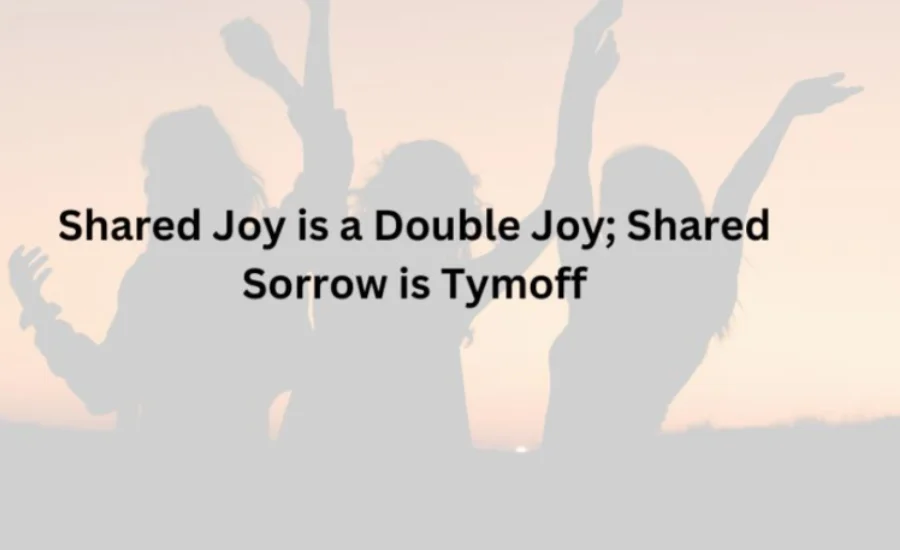The saying “Shared joy is a double joy; shared sorrow is tymoff” highlights how emotions, whether joyous or painful, are amplified or alleviated through sharing. This idea is deeply embedded in human psychology and sociology. When we share our happiness, it often feels as though the joy is magnified, fostering a stronger sense of connection and satisfaction. Conversely, sharing our grief doesn’t necessarily intensify the pain but helps distribute it, making it more manageable. This mutual exchange of emotions underscores the profound impact of communal support and empathy in our lives.
The Impact of Shared Emotions
The notion that “Shared joy is a double joy; shared sorrow is tymoff” emphasizes the profound effect of sharing our feelings with others. Celebrating happiness with someone else can make the joy feel even more significant, while expressing sadness with a trusted friend or group can make the burden easier to bear. This concept underscores how shared experiences foster a deep connection between people, whether they are reveling in success or navigating through grief. Embracing this idea encourages openness about our emotions, highlighting the vital role that relationships and emotional sharing play in enhancing personal happiness and facilitating emotional healing.
The Joy of Shared Happiness
Shared joy often feels more profound than experiencing happiness alone, largely due to the way social bonding enhances our emotional responses. When we celebrate a happy moment with others, it strengthens our connections and activates the brain’s reward centers. Research suggests that witnessing others’ happiness, especially when it stems from something we’ve facilitated, stimulates pleasure and arousal circuits in the brain.
This concept is evident in everyday life. For example, organizing a surprise party for a friend and seeing their delighted reaction can bring you immense joy. Similarly, recalling a funny experience shared with a close friend often brings a smile to your face, thanks to the shared laughter and inside jokes. These shared moments not only create lasting memories but also reinforce our social bonds, highlighting the powerful impact of communal joy on our emotional well-being.
The Science Behind Shared Emotions
The concept that “shared joy is double joy; shared sorrow is half sorrow” is supported by scientific research into how our brains handle emotions. When we share happiness, our brains release dopamine, often called the “feel-good” hormone, which amplifies our positive feelings. This explains why celebrating achievements or good news with others can heighten our sense of joy. Additionally, the release of oxytocin, known as the “bonding hormone,” when sharing emotions, further strengthens interpersonal connections.
Conversely, sharing sorrow with others can help lighten the emotional load. Discussing grief or sadness with supportive individuals often triggers the prefrontal cortex, which plays a key role in emotional regulation. Research indicates that such emotional exchanges provide validation, empathy, and comfort, reducing the intensity of negative feelings and easing emotional pain. This dual impact of sharing—enhancing joy and alleviating sorrow—demonstrates its essential role in maintaining emotional well-being and processing complex feelings in a more balanced manner.
The Comfort of Shared Sorrows
While joy grows through sharing, sorrow tends to diminish in its intensity when shared. During times of tragedy or difficulty, opening up to trusted friends and family can significantly lessen the emotional burden. Here’s how sharing sorrow makes a difference:
Expressing our struggles to empathetic listeners helps in processing our emotions. It transfers some of the mental strain onto others, who offer their support and understanding.
Understanding that others have faced similar hardships can make us feel less isolated in our grief.
Receiving both practical and emotional support from a supportive network lightens our load, reduces stress, and instills hope.
Different perspectives shared by others can offer new insights and solutions that we might not see on our own during tough times.
This principle becomes evident when we support those in distress. A listening ear or a compassionate presence can ease their suffering, much like historical examples where communities came together to recover from disasters. This collective approach not only alleviates individual pain but also fosters resilience and recovery within communities.
The Benefits of Sharing Emotions

Sharing both joy and sorrow offers a range of valuable benefits that enhance our lives in meaningful ways. When we open up about our experiences, we strengthen relationships by building trust, intimacy, and a deeper mutual understanding. Social support plays a crucial role in mental health, contributing significantly to our overall well-being and happiness. By sharing our experiences, we also combat feelings of isolation, ensuring that we don’t navigate life’s highs and lows alone.
Moreover, discussing our emotions with others often provides new perspectives, revealing aspects we might overlook when immersed in a situation. Engaging in shared experiences can give us a sense of purpose, as helping others and contributing to their happiness brings meaning to our own lives. It also fosters emotional regulation, as talking about our feelings with empathetic individuals promotes healthier emotional processing.
Additionally, facing challenges together can build resilience, preparing us to handle future difficulties with greater strength. In essence, whether during moments of celebration or times of struggle, sharing our experiences enriches our well-being, deepens our connections, and supports our growth as individuals and communities.
The Joy of Sharing Celebrations
When we share moments of joy, our happiness doesn’t just stay the same—it multiplies. Reflect on a time when you received exciting news. Did it feel even more special when you celebrated with friends or family? The joy we experience is heightened when others join in our celebration. This phenomenon is evident in various scenarios, such as community events, team successes, or personal milestones. As social beings, our brains are naturally inclined to seek connection, which is why sharing positive experiences often amplifies our sense of fulfillment.
Moreover, sharing joyful moments also strengthens our relationships. It deepens emotional bonds, builds trust, and enhances intimacy. Whether it’s a friend’s promotion, a family member’s wedding, or a personal achievement, sharing these occasions fosters a sense of community and mutual support. By involving others in our happiness, we not only enrich our own emotional experience but also contribute to their well-being, making the joy of sharing a collective and enriching experience.
The Power of Sharing Life Stories
One of the most profound ways to connect with others is through sharing our life stories. These narratives offer deep insights into our personalities, values, struggles, and achievements. Storytelling not only brings us closer together but also helps us understand one another on a more personal level.
Sharing our stories can strengthen connections by fostering empathy and understanding. It allows us to reflect on our journeys and recognize how we’ve evolved over time. Our experiences can also inspire others, providing hope and courage through our challenges and triumphs. Additionally, discovering new facets about people we know well can maintain and deepen our relationships, despite time and distance.
Exchanging perspectives and life lessons through storytelling broadens our worldview and enriches our understanding of different experiences. Significant stories often create lasting memories, reinforcing our relationships and the sense of shared history. For communities, sharing heritage and history nurtures pride, identity, and support systems.
Ultimately, embracing the art of storytelling can become a treasured practice that builds stronger, more meaningful relationships founded on mutual trust and understanding. It underscores how sharing our personal journeys can enhance both individual connections and community bonds.
Finding Comfort in Shared Sorrows
Grief and sadness can feel overwhelmingly heavy when faced alone. However, sharing our sorrow with others often provides significant relief. While it may not erase the pain, opening up about our emotional struggles can make them more manageable. Discussing our grief with someone else invites understanding, empathy, and support, which can lighten the emotional burden. Research indicates that sharing sorrow helps build emotional resilience, allowing individuals to process their feelings in a more constructive and healthy manner.
Furthermore, receiving support during difficult times can be incredibly comforting. Knowing that others understand or have experienced similar challenges can reduce feelings of isolation. It strengthens emotional connections and reassures us that we don’t have to navigate tough moments alone. Sharing our sorrow plays a crucial role in the healing process, reinforcing the notion that we are never truly alone in our struggles.
The Joy of Service and Giving

Sharing experiences through service and giving significantly amplifies positivity. Engaging in voluntary work, making charitable donations, or performing acts of kindness not only benefits others but also enriches our own lives. Helping those in need triggers the brain’s reward systems, enhancing our sense of happiness and fulfillment.
Volunteering offers valuable life lessons by exposing us to various social issues and diverse communities. It also sets an example of generosity, encouraging others to contribute and spread goodwill. Collective efforts in community service strengthen social ties and foster a sense of shared humanity, bridging divides and building stronger connections.
Moreover, small acts of kindness can initiate a ripple effect, inspiring further acts of generosity and expanding their impact. Giving cultivates social capital by fostering reciprocal support networks, benefiting both the giver and the receiver. By dedicating our time, talents, and resources to service, we create a more compassionate and interconnected society, enriching the lives of everyone involved.
The Power of Shared Emotions
One reason shared emotions have such a profound effect is the power of social validation. When others acknowledge and celebrate our feelings, it not only enhances our emotional state but also strengthens our social connections.
When our emotions are recognized and affirmed by others, it fosters a sense of belonging and acceptance. This is especially impactful during joyful moments, as it amplifies our happiness.
Emotional mirroring, where we observe others experiencing similar emotions, also intensifies our feelings. This mirroring effect makes joy more vibrant and helps ease sorrow by sharing the emotional load.
The collective nature of shared emotions creates a ripple effect, amplifying both joy and sorrow. By connecting with others during emotional experiences, we enhance the overall impact of those feelings, making them more profound.
The Importance of Communication in Sharing Emotions
Effective communication is essential when it comes to sharing emotions. Whether expressing joy or grief, how we convey our feelings can shape the emotional connections we build with others. Clear, honest communication allows us to fully articulate our emotions, making it easier for others to understand and respond meaningfully. For instance, sharing joy is more than just saying, “I’m happy”; it’s about explaining why you feel that way and inviting others to be part of that experience.
When it comes to sorrow, communication becomes even more important. Discussing grief or hardship requires vulnerability and trust, giving others the opportunity to offer emotional support. Listening is just as crucial—being a compassionate listener can help someone feel truly understood and cared for. This mutual exchange deepens relationships and strengthens emotional bonds.
Everyday Examples of the Power of Shared Emotions

The wisdom behind the saying “shared joy is a double joy; shared sorrow is tymoff” is evident in many everyday moments:
- Family Celebrations: When a family gathers to celebrate a birthday, the happiness of the occasion is multiplied for each member as they share the experience together.
- Friends Supporting Each Other: After a breakup, friends who listen and offer comfort help ease the emotional burden, making the sorrow more bearable.
- Team Bonding: Colleagues working on community projects together experience a boost in team spirit and morale through their shared positive efforts.
- Parental Support Groups: Parents facing challenges, such as their child’s illness, find comfort and understanding in support groups, reducing their individual worries.
- Sibling Memories: Siblings reminiscing about funny childhood moments strengthen their bond, deepening their relationship through shared laughter.
- Couples Building Intimacy: When couples face tough times, sharing vulnerabilities strengthens their connection, and working through the hardships together eases emotional pain.
- Community Support: When a community rallies to help families affected by disasters, whether through fundraisers or rebuilding efforts, shared responsibility and care lighten the load for everyone.
In all these situations, shared experiences not only multiply happiness but also ease sorrow, reinforcing the notion that we thrive emotionally through connection with others.
Sharing joy and sorrow is essential to human connection, and small gestures of gratitude, such as gifting a friendship bracelet or an enamel pin badge, can be meaningful ways to express appreciation to those who support us. Tangible tokens can serve as a reminder of the invisible love and care shared among friends, family, and communities.
Cultural Approaches to Sharing Emotions
Different cultures have distinct ways of expressing and sharing emotions, particularly when it comes to the idea that “shared joy is a double joy; shared sorrow is tymoff.” In collectivist cultures, such as those found in parts of Asia and Africa, emotional experiences are often seen as communal events. Celebrations like weddings and festivals, as well as mourning rituals, become community-wide gatherings. The entire group participates, making the emotional experience—whether joy or grief—one that is shared and amplified by the collective.
On the other hand, individualistic cultures, like those in the U.S. and much of Western Europe, place greater emphasis on personal expression. While emotions are still shared, the focus tends to be on individual achievements or personal loss. Despite this, the act of sharing joy or sorrow remains important in building and maintaining close relationships.
Understanding these cultural differences in emotional sharing can help us communicate more effectively in an increasingly globalized world. Whether from a collectivist or individualistic culture, recognizing the role that sharing emotions plays in strengthening social bonds is key to navigating diverse relationships.
The Power of Sharing Sorrow
Sharing sorrow with others can greatly ease the emotional weight we carry during difficult times. Having someone to talk to makes challenging experiences more bearable and helps us process our emotions in a healthier way.
Emotional Support: When we share our sorrows, we gain crucial emotional support, helping us cope with stress and adversity. This support strengthens our resilience and provides a sense of comfort.
Stress Relief: Talking about our troubles helps reduce stress by releasing harmful stress hormones like cortisol. Sharing sorrow can alleviate the negative impact prolonged stress has on our physical and mental well-being.
In essence, “shared joy is a double joy; shared sorrow is tymoff” because sharing sorrow lightens the emotional load. It builds solidarity, deepens mutual understanding, and fosters stronger connections.
The Science Behind Sharing Emotions

Scientific research confirms that sharing emotions, whether joyful or sorrowful, has measurable benefits for both mental and physical health. A key player in this process is oxytocin, often called the “bonding hormone.”
Oxytocin and Empathy: Oxytocin is essential not just for bonding, but also for fostering empathy. When we share our emotions with others, oxytocin levels rise, boosting our ability to connect with and understand others on a deeper emotional level.
Empathy’s Impact: Empathy allows us to share and comprehend the feelings of others, which is critical for forming strong, supportive relationships.
Oxytocin’s Influence: The release of oxytocin during shared emotional experiences enhances empathy and compassion, reinforcing our social bonds.
Embracing the Art of Emotional Sharing
Sharing emotions, whether they’re joyful or sorrowful, involves both practice and mindfulness. For many, opening up can be challenging, but starting with small, manageable steps can help integrate emotional sharing into daily life.
Begin by sharing small moments of joy, such as daily successes or positive experiences. Celebrate others’ achievements and offer genuine compliments. For instance, acknowledging a colleague’s success or expressing excitement over a friend’s good news can help build a habit of emotional sharing.
When it comes to sharing sorrow, creating a safe space is essential. Open up about your feelings with trusted friends and be prepared to listen when others need to talk about their own struggles. Mindfulness can aid in recognizing and expressing emotions as they arise, rather than keeping them bottled up. Practicing empathy and active listening strengthens emotional bonds and fosters a supportive, connected community.
Keep discovering with more resources and articles on Alevemente.




